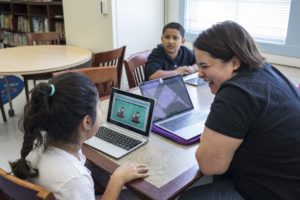Share this
Engage your K-5 Students with These 5 Reading Tips
by Team BookNook on Dec 13, 2018 1:08:32 PM
Engaging students in meaningful conversations about what they are reading is so important in helping students get the most out of instructional time. Getting students engaged in reading and talking about what they are reading will encourage them to develop deeper comprehension skills, practice higher-level critical thinking skills and make connections with the text and each other. Several studies have demonstrated a positive correlation between behavioral engagement and achievement-related outcomes for elementary and high school students (Connell, Spencer & Aber, 1994; Marks, 2000; Newmann et al., 1992; Skinner, Wellborn, & Connell, 1990).
So what exactly is an engaged reader?
An engaged reader actively thinks about what they are reading- absorbing, reflecting and predicting. They are involved at a deep level and motivation is inherent. In this article you will find tips that will help you create a more engaging, student-centered approach in your classroom, while also maintaining structure.
What studies show
As educators, we know that home influence plays a large role in students’ reading habits as well as motivation, and that many children enter the classroom at a disadvantage because of this. Research has found that helping students become more engaged with reading while at school can have a significant impact on their overall reading habits and skills. This is supported by a study done in 1999 by Guthrie and Schafer that was a secondary analysis of 1994 NAEP data:
Guthrie and Schafer (1999) found that engaged readers have much better text comprehension and reading achievement than do disengaged readers. Beyond that simple fact, however, engaged reading can overcome major obstacles to achievement. For example, low levels of education in the family and low income usually pose obstacles to reading achievement. Students with less-educated mothers nearly always score lower in reading comprehension than students whose mothers have more education. However, Guthrie and Schafer found that engaged readers who had mothers with a low level of education achieved more highly than disengaged readers who had highly educated mothers. For example, a student with a less-educated mother who reads “almost every day” for enjoyment has a better reading achievement and text comprehension than a student who reads “never or hardly ever” but has a mother who is highly educated. A similar relation occurs for engaged reading and income. Low-income students (receiving free or reduced-price lunch) who were engaged readers scored highly on achievement tests. These engaged readers were comparable in text comprehension to students with higher income (not receiving free or reduced-price lunch), but who were disengaged readers (Baker, Dreher, Guthrie, 2000).
Studies like this demonstrate how significant a teacher’s influence can be on a child’s view towards reading.
Show genuine interest

As a teacher I find it easy to get caught up in the motions and not take the time to truly engage students in a deep, meaningful conversation about what we just read. It’s understandable to try to increase the engagement of your entire class by moving quickly through post-reading questions. However, I’ve found that jumping from student to student and question to question tends to lead to less interesting dialogue and poorer engagement. This results in your students feeling a lack of interest on your part. Remember: quality over quantity. Your students desire not only to be heard, but to feel listened to. You can show them that you are listening to them by taking notes and asking specific follow-up questions. I promise you that if you do this, your students will feel valued, be more likely to share, and will give their answers much more thought.
“Heart connections”
Another way to show your genuine interest, is to encourage students to draw connections from the literature to their personal lives. These personal associations, often referred to as “heart connections,” animate the readings and make them more relatable to students. This method will drive higher amounts of quality discussions with students while decreasing mediocre student answers. Because of time constraints, only a few students will be able to share out loud. This is why I recommend utilizing partner shares and written reflections to hold all students accountable and give everyone a chance to share their thoughts in some way.
Ask open-ended questions
Open-ended questions are questions that don’t have a right or wrong answer, which makes kids feel more comfortable engaging in conversation. Open-ended questions also encourage more than just yes or no responses and provide the opportunity for a real conversation to be had. Some examples of book related open-ended questions are:
- Which characters in the books would you like to meet in real life?
- What part of the book did you think was the most exciting?
- How would you change the book’s ending if you could rewrite it?
- If you could be a character in the book for one day, who would you chose to be and why?
- If you could be friends with any character in the book, who would you like to be friends with and why?
- What do you think the author wanted us to take away from this book?
- Would you read other books from this author? Why or why not?
- Is there anything in this story that is similar to something that has happened in your life? What was it and how is it familiar?
- Did any of the characters remind you of someone?
- Would this book make a cool movie? Video game? TV show? Why or why not?
You can always further extend questions by asking, “Why?” or “Tell me more.” If a student responds to a question by saying, “I don’t know,” you can respond by saying, “Well let’s think about it.” Saying “I don’t know” might just be a reflex for the student, in which case just give them some time to think without pressuring them! If a student gives a short answer, you can say things like, “Tell me more about that” or “What led you to that answer/belief?”
Projects related to reading
Some young students get so nervous when the class is having a discussion. This means that even though they may have some great questions in mind or answers to contribute, they are too shy or anxious to raise their hand or may freeze up when the attention is on them. Combating an environment of anxiety starts with you, the facilitator of learning. You can create a more casual setting for students to discuss reading by having them create brochures about where their book took place, write a letter as their character, create a board game, book board or poster about their book, create a test about the book(including answer sheet), write an advertisement to encourage other children to want to read the book or have students bring stories to life by creating a 3-D scene from their book. Projects on reading give students time to think and reflect on their thoughts on the reading and present them in an orderly fashion that makes sense to them.
Reflection Time
I know this one is a tough one. When you ask a question, give your students ample time to gather their thoughts and reflect. This is also a great opportunity for students to share feedback with their peers or in a small group before responding to the question to the whole class. As a teacher, it can feel uncomfortable waiting in silence, but students will greatly benefit from this reflection time. By allowing them to think of meaningful responses that will spark an engaging dialogue, everyone wins.

One way to maximize reflection time is to ask your students to write their initial thoughts about the post-reading questions on a mini journal/notepad. Then, have them break up into mini groups of 3-4 and share what they wrote down. The group can then share with the class what they discovered after conversing in their groups. Not only does this exercise encourage everyone to speak up, it also promotes collaboration and teamwork! I strongly recommend talking to your students about what reflection time is and why it is important. I’ve found that explaining the benefits of reflection time makes students feel engaged and empowered.
Make it fun

If you make book discussions fun and engaging it will calm your students’ nerves and make the discussion less formal and more inviting. Below are a few ideas to spice up book discussions:
- Games that include questions about the reading are a great way to facilitate book discussions in a fun way. I’ve seen this done by creating a board game, dice game and even common reading questions written on a beach ball that you toss around the class and have students choose a question about the story to answer.
- If you’re starting a new book, it might be fun to add some decorations to the classroom that are related to the book or dress up like a character from the reading.
- Having other staff members at your school be a part of bringing a story to life really adds to the fun and also helps build community. With younger students, I’ve had our principal, secretary, school specialists and parents deliver mail, messages or packages to our class from characters from our stories. I’ve also seen guests dress up as characters and come to a classroom for a Q&A session with students.
- Game show or trivia game – create questions related to reading, form teams and maybe even have some prizes!
- Change where you read – the school garden, field in the schoolyard, school library or perhaps a nearby park.
- Plan a field trip around reading – if the story took place somewhere you are able to bring your students(or somewhere somewhat similar) this is a great opportunity to connect your students to the reading and their community.
Learn how BookNook helps engage young readers:
Research
Baker, L., Dreher, M., Guthrie, J. (2000). Engaging Young Readers: Promoting Achievement and Motivation. New York, NY: The Guilford Press.
Connell, J. P., Spencer, M. B., & Aber, J. L. (1994). Educational risk and resilience in African American youth: Context, self, action, and outcomes in school. Child Development, 65, 493-506.
Marks, H. M. (2000). Student engagement in instructional activity: Patterns in the elementary, middle, and high school years. American Educational Research Journal, 37, 153-184.
Newmann, F., Wehlage, G.G., & Lamborn, S. D. (1992). The significance and sources of student engagement. In F. Newmann (Ed.), Student engagement and achievement in American secondary schools (pp. 11-39). New York: Teachers College Press.
Skinner, E. A., Wellborn, J. G., & Connell, J. P. (1990). What is takes to do well in school and whether I’ve got it: The role of perceived control in children’s engagement and school achievement. Journal of Educational Psychology, 82, 22-32.
University of Washington: Center of Teaching and Learning. Engaging Students in Learning.
Retrieved from: https://www.washington.edu/teaching/teaching-resources/engaging-students-in-learning/
For further reading on this subject, check out the below articles:
How to Encourage Students to Read for Pleasure: Teachers Share Their Top Tips
Let’s Stop With the Worksheets and Create Engaged Learners
Tell Us More: Reading Comprehension, Engagement and Conceptual Press Discourse
Share this
- April 2024 (3)
- March 2024 (5)
- February 2024 (3)
- January 2024 (5)
- December 2023 (3)
- November 2023 (5)
- October 2023 (5)
- September 2023 (5)
- August 2023 (4)
- July 2023 (5)
- June 2023 (8)
- May 2023 (3)
- April 2023 (3)
- March 2023 (4)
- February 2023 (1)
- January 2023 (1)
- November 2022 (1)
- October 2022 (1)
- September 2022 (1)
- August 2022 (1)
- June 2022 (1)
- April 2021 (1)
- March 2021 (1)
- October 2020 (1)
- December 2019 (1)
- November 2019 (1)
- October 2019 (1)
- September 2019 (2)
- July 2019 (1)
- January 2019 (1)
- December 2018 (1)
- October 2018 (1)
- August 2018 (1)
- May 2018 (2)
- April 2018 (1)
- March 2018 (2)
- February 2018 (2)